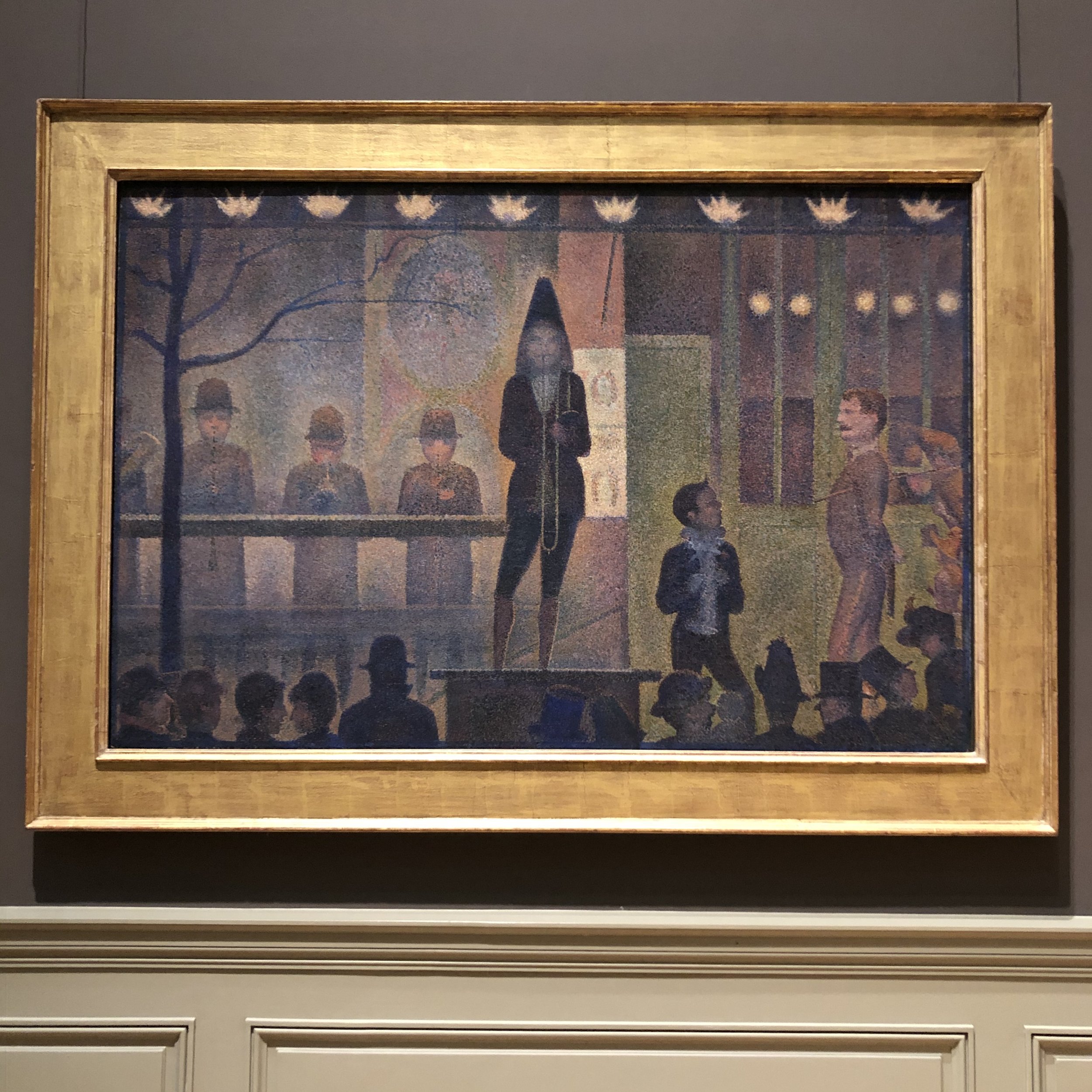Nineteenth century France was a time and place full of excitement around new modes of art making. Of the avant garde schools that took shape in this moment, the Impressionists are the best known and most widely revered. Defined by Monet’s sensuous treatment of subjects ranging from cathedrals to haystacks, the appeal of the Impressionists is hard to escape. Other contemporary movements, such as the Pointillists, sought to broker new ways of seeing as well, and with dazzling effects. Georges Seurat’s Circus Sideshow is a signature product of the thrilling nineteenth century and shows off the spectacle inherent in the Pointillist mode.
The Pointillists, led in large part by Seurat, aimed to dissolve the picture plane into innumerable inflections of paint. The eyes of viewers would reassemble these dots, completing the intended image in the heads of onlookers. Based on a novel and sophisticated understanding of optics, the works produced by the Pointillists have a scintillating quality that is unlike the works produced by their earlier counterparts. While Monet’s paintings might make one marvel at light or atmosphere, Seurat’s hinge on something more complex. They make the viewer consider how a picture is constructed, diffused, received, and absorbed.
Seurat’s Circus Sideshow, now in the collection of the Metropolitan Museum, leverages the stylistic flourishes of Pointillism to underscore the showmanship of its subject. Musicians are seen playing under gaslight and over the heads of a crowd eagerly hoping to gain admittance to a circus proper. The hum of the gathered group seems implicit in the daubs of paint spread across the surface of Seurat’s canvas. It is a painting about the buzz of a public event, and that exciting atmosphere is perfectly attuned to Seurat’s technique. Each dot of paint can be read as a warbling note of sound, or as the glint of twilight, or as a dash of the vibration of the rowdy mob.
Georges Seurat, Circus Sideshow (Parade du Cirque), 1887-1887, on view at The Metropolitan Museum of Art
The image was exhibited at the Salon des Indépendants in 1888. In displaying this vivid nocturne, Seurat was playing a bit of a game with his audience. Like a circus, French salons of all types were about showmanship. Paintings were designed to stop the crowd, to draw them in, to rile them up. Seurat’s image is no different. Its stylistic treatment, novel when it was painted, is still surprising and exciting today. Looking at the painting, one gains a sense of atmospheric dramatism that surpasses many comparable works of the Impressionists. Seurat’s Pointillists sought to build upon the groundbreaking works of the likes of Monet, whose famed Impression Sunrise was completed sixteen years prior to Seurat’s engaging Sideshow.
The event at the heart of Seurat’s grand painting was a proceeding designed to entice passersby to become customers. Through showmanship, this tertiary scene was supposed to turn viewers into ticket-buyers and bring them under the big tent. It was about allure. In this way, the sideshow and Pointillism overlap. They are both full of eye-catching spectacle.
Pointillism was designed to catch, and hold, and entrance the eye. The effect remains and even today Pointillist works bring the viewer back again and again.
Seurat’s interest in circus imagery was deep and the motif appears a number of times throughout his oeuvre. The Met’s Circus Sideshow is one of his largest and most stunning artworks and one that easily defines the movement. It, like the evening it depicts, is a grandiose and exciting extravaganza.
By looking at Circus Sideshow, viewers become both onlookers of art and participants in a public spectacle. They might be dazzled by Seurat’s composition, or by his palette, or by the Pointillist technique. They also become the crowd, like the one the artist captured, waiting in line for a chance to get a closer look at the show.
A detail from Seurat’s Circus Sideshow


